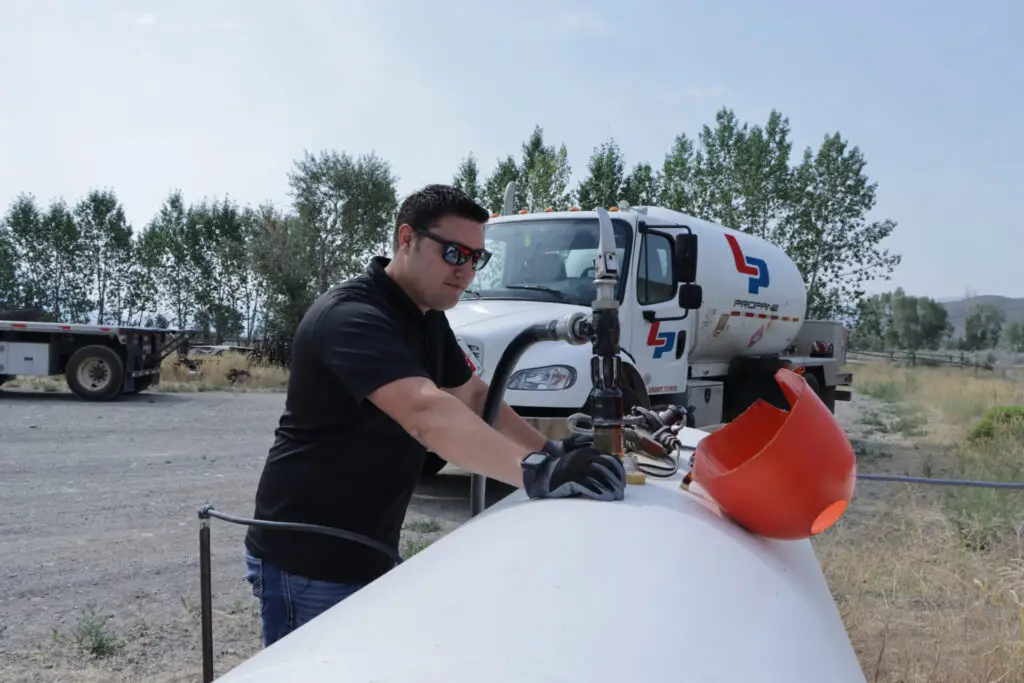How to Calculate the Right Propane Tank Size:
A Guide for Colorado Homeowners
optimizing costs
Starting as a new propane customer, we know how crucial it is to choose the right propane tank size for your home. It’s not just about ensuring you have enough fuel; it’s about optimizing your costs and making sure your home stays warm and comfortable, especially during those cold winters. Let’s dive into how to calculate the right propane tank size for your needs.
Understanding Your Propane Needs
Common Propane Uses in Suburban Homes
First things first, understanding your propane needs is essential. Propane is a versatile fuel used for various home appliances, including:
- Heating: Furnaces and space heaters
- Cooking: Stoves, ovens, and grills
- Water Heating: Tank and tankless water heaters
- Clothes Drying: Propane dryers
- Fireplaces: Indoor and outdoor
- Pools and Hot Tubs: Heaters
Each of these uses contributes to your overall propane consumption that can effect propane cost. For example, my own home uses propane for heating, cooking, and our cozy living room fireplace.
Factors Affecting Propane Usage
Several factors impact how much propane you’ll need:
- Home Size: Larger homes require more propane to heat.
- Number of Appliances: More propane appliances mean higher usage.
- Climate: In Colorado, the cold winters significantly increase propane usage for heating.
Types of Propane Tanks
Different Sizes of Propane Tanks
Propane tanks come in various sizes, each suitable for different needs:
- 100-Gallon Tanks: Ideal for small homes or limited use, such as cooking and a single appliance.
- 250-Gallon Tanks: Suitable for homes with two or three propane appliances.
- 500-Gallon Tanks: Common for average-sized homes with multiple appliances.
- 1,000-Gallon Tanks: Best for large homes or properties with extensive propane needs.
When my family moved to Colorado, we started with a 250-gallon tank. As our propane usage increased with additional appliances, we upgraded to a 500-gallon tank.
Above-ground vs. Underground Tanks
You can choose between above-ground and underground tanks:
- Above-ground Tanks: Easier to install and maintain but may be less aesthetically pleasing.
- Underground Tanks: Hidden from view but require excavation and higher installation costs.
Calculating Your Propane Usage
Average Propane Usage for Common Appliances to optimize Cost
- Furnaces: 1,000-1,500 gallons per year
- Water Heaters: 250-400 gallons per year
- Stoves/Ovens: 50-100 gallons per year
- Clothes Dryers: 35-50 gallons per year
- Fireplaces: 200-300 gallons per year
- Pool Heaters: 400-1,000 gallons per year
Using Propane Usage Calculators
Online propane usage calculators can help estimate your needs more precisely. Simply input the number and type of propane appliances you have to get a rough idea of your annual consumption.
Factors to Consider When Choosing a Tank Size
Home Size and Insulation Quality
Larger homes and homes with poor insulation will use more propane. Ensuring your home is well-insulated can reduce your propane needs and save you money in the long run.
Number of Propane Appliances
The more propane appliances you have, the larger the tank you’ll need. When we added a propane pool heater, our usage spiked, prompting us to upgrade our tank.
Frequency of Propane Delivery
Consider how often you want propane delivered. Larger tanks mean fewer deliveries, which can be more convenient and sometimes cheaper.
Future Plans
If you plan to expand your home or add more propane appliances, choose a tank size that accommodates future growth. It’s better to plan ahead than to constantly upgrade to help with propane cost.
Consulting with a Propane Professional
Importance of a Professional Assessment
Getting a professional assessment ensures you choose the right tank size. A professional can evaluate your home, appliances, and usage patterns to recommend the best option.
What to Expect During a Consultation
During a consultation, a propane professional will perform the following for the best propane cost.
- Inspect your home and appliances
- Discuss your usage habits and future plans
- Provide a detailed estimate of your annual propane needs
When we had our consultation, the expert pointed out that our growing family and new propane fireplace would significantly increase our usage, guiding us to choose the 500-gallon tank.
You can also save on propane cost with an Auto Fill propane plan.

Installation and Maintenance of Propane Tanks
Steps Involved in Propane Tank Installation
Installing a propane tank involves several steps:
- Site Assessment: Determine the best location for the tank.
- Permitting: Secure any necessary permits.
- Installation: Set up the tank and connect it to your appliances.
- Safety Check: Ensure everything is working correctly and safely.
Regular Maintenance and Inspections
Regular maintenance keeps your propane system running efficiently. Schedule annual inspections to check for leaks, test connections, and ensure optimal performance.